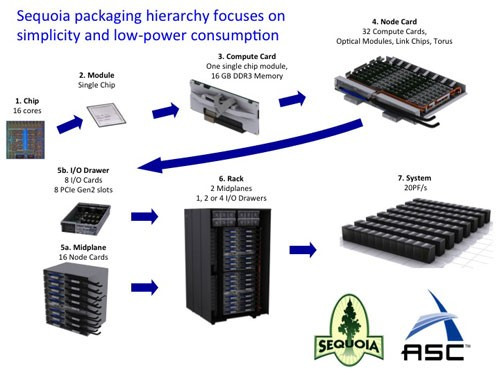US-based Sequoia Supercomputer is Fastest in the World [VIDEO]
For the first time in almost three years, the US has regained the title of owning the fastest computer on the planet.

Heading the list of the Top 500 Supercomputers, published this morning, is the huge Sequoia supercomputer based at the US Department of Energy's Lawrence Livermore National Laboratory (LLNL) in California.
The IBM BlueGene/Q system takes top spot with a speed of 16.32 petaflops (Pflop/s), which means it is capable of carrying out more than 16 thousand trillion calculations per second. The computer features 96 racks, 98,304 computer nodes, 1.6 million processing cores and 1.6 petabytes of memory.
FLOPS (or floating point operation per second) is a measure of a computer's performance and is measured using the Linpack benchmark, originally written back in the 1970s.
As well as being the fastest supercomputer on the list, Sequoia is also one of the most energy efficient. It uses 7,890 kilowatts of power, compared to 12,659 kilowatts for the second-best K Computer.
To get to top spot, Sequoia ran the benchmark for 23 hours with a single core failing, LLNL division leader Kim Cupps told website Ars Technica on Friday.
"For a machine with 1.6 million cores to run for over 23 hours six weeks, after the last rack arrived on our floor is nothing short of amazing," she said.
Sequoia is capable of hitting 20 Pflop/s according to Cupps, having run at 81 percent efficiency during the tests.
Currently the cluster is open to a wide range of scientists on a relatively open network, however once IBM has finished debugging the system sometime in early 2013, it will be moved to a classified network and used exclusively to carry out simulations aimed at extending the lifespan of nuclear weapons.

"The kind of science we need to do is lifetime extension programs for nuclear weapons," Cupps told Ars Technica. "That requires suites of codes running. What we're able to do on this machine is to run large numbers of calculations simultaneously on the machine. You can turn many knobs in a short amount of time."
Japan's K-Computer
The US-based supercomputer has taken top spot from Fujitsu's "K Computer" which is installed at the RIKEN Advanced Institute for Computational Science (AICS) in Kobe, Japan and held the top spot on the previous two lists.
K Computer is now the number two system with 10.51 Pflop/s on the Linpack benchmark using 705,024 SPARC64 processing cores.
The most powerful system in Europe and number four on the list is SuperMUC, an IBM iDataplex system installed at Leibniz Rechenzentrum in Germany. Another German machine, the JuQUEEN BlueGene/Q at Forschungszentrum Juelich, is number eight.
Looking at the processors themselves, a total of 372 systems (74.4 percent) are now using Intel technology, down from 384 systems (76.8 percent) on the last list.
Intel is now followed by the AMD Opteron family with 63 systems (12.6 percent), the same as in the in the previous list. The share of IBM Power processors has increased from 49 to 58 systems (11.6 percent).
© Copyright IBTimes 2025. All rights reserved.






















